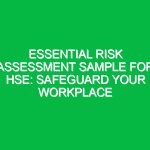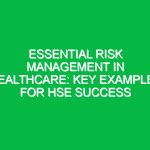Introduction
Hello team, and welcome to our Toolbox Talk today! Our focus will be on a critical aspect of Workplace Safety: Recognized vs Unrecognized Hazards. Understanding these differences is essential for maintaining a safe work Environment and preventing accidents. By the end of this talk, you’ll have a clearer understanding of how to identify these Hazards in your daily operations and what steps to take to mitigate them. So, let’s dive in!
What Are Recognized Hazards?
Recognized hazards are those risks that have been identified and acknowledged within the workplace. These hazards are documented, understood, and often addressed through established Safety protocols and Procedures. Some common examples include:
- Slips, trips, and falls: Wet floors or uneven surfaces.
- Electrical Hazards: Exposed wires or improperly grounded equipment.
- Chemical exposure: Handling hazardous materials without proper protection.
Recognized hazards are typically accompanied by specific Control Measures. For instance, if a wet floor is identified, proper signage and cleaning protocols should be in place to prevent accidents.
The Importance of Recognizing Hazards
Recognizing hazards is crucial for several reasons:
- Prevention of Accidents: Proactively identifying hazards helps prevent workplace injuries.
- Compliance: Adhering to Safety Regulations and Standards is essential for legal compliance.
- Promoting Safety Culture: When employees are aware of recognized hazards, they contribute to a culture of safety.
During our operations, it’s vital to remain vigilant about these hazards and encourage each other to report any new observations.
What Are Unrecognized Hazards?
In contrast, unrecognized hazards are risks that have not been identified, acknowledged, or adequately addressed. These hazards can often lead to unexpected accidents because they are hidden or overlooked. Some examples include:
- Fatigue: Employees may not recognize the impact of tiredness on their performance.
- Inadequate Training: Lack of awareness about safety procedures can lead to errors.
- Environmental factors: Poor air quality or noise levels that go unnoticed.
Unrecognized hazards pose a significant risk because employees might not be aware of the dangers they face, leading to accidents and injuries.
The Dangers of Unrecognized Hazards
Unrecognized hazards can be particularly dangerous for several reasons:
- Unexpected Incidents: These hazards can lead to sudden accidents that catch employees off guard.
- Compounding Risks: When unrecognized hazards combine with recognized ones, the risk of accidents increases significantly.
- Increased Liability: Failure to address these hazards can result in legal consequences for the company.
Identifying Recognized vs Unrecognized Hazards
Now that we’ve discussed the definitions, how can we effectively identify these hazards in our work environment? Here are some practical steps:
- Conduct Regular Risk Assessments: Schedule periodic assessments to identify potential hazards. Include employee input to spot issues that may be overlooked.
- Encourage Open Communication: Foster an environment where employees feel comfortable reporting hazards. Regular safety meetings can help facilitate this.
- Utilize Checklists: Use checklists during inspections to ensure that all areas are evaluated, including those that may harbor unrecognized hazards.
- Training and Awareness: Regularly train employees on how to recognize hazards and the importance of reporting them.
Real-Life Scenario
Let’s consider a hypothetical scenario to illustrate these concepts. Imagine our team is working on a construction site. The team has identified that the area is prone to slips due to wet surfaces. This is a recognized hazard, and proper signage is in place. However, an unrecognized hazard might be the fatigue of workers who have been on the job for too long without breaks. If fatigue leads to decreased attention and slower reaction times, accidents are more likely to occur.
This example highlights the importance of not only recognizing hazards but also being aware of potential unrecognized risks. It’s crucial to address both to maintain a safe work environment.
Best Practices for Managing Hazards
To effectively manage both recognized and unrecognized hazards, consider the following Best Practices:
- Regular Training: Ensure all employees are trained on safety protocols that address both recognized and unrecognized hazards.
- Team Meetings: Use team meetings to discuss any hazards identified in the workplace and how to mitigate them.
- Emergency Preparedness: Develop and practice emergency response plans for various scenarios. This preparation can help address unrecognized hazards when they arise.
- Feedback Mechanism: Create a system for employees to provide feedback on hazards they encounter, ensuring continuous improvement.
Importance of Compliance and Standards
Understanding Recognized vs Unrecognized Hazards is not just about safety; it’s also about compliance with regulations. Organizations like OSHA (Occupational Safety and Health Administration) set standards aimed at ensuring Workplace Safety. By complying with these standards, you not only protect yourself but also your coworkers and the company.
Failure to comply with safety standards can result in serious repercussions, including fines, legal action, and increased insurance premiums. Therefore, understanding and managing both recognized and unrecognized hazards is vital for legal compliance and the overall safety of the workplace.
Open Discussion
Now, let’s take a moment to open the floor for discussion. What hazards have you observed in your work areas? Are there any unrecognized risks that you think we should address? Sharing these insights can help us all stay safe and informed.
Conclusion
In conclusion, recognizing the difference between Recognized vs Unrecognized Hazards is essential for maintaining a safe workplace. By identifying and addressing both types of hazards, we can significantly reduce the risk of accidents and injuries. Remember, safety is everyone’s responsibility, and your input is invaluable in this effort.
Thank you all for your attention and commitment to ensuring a safe working environment. Let’s continue to work together to keep our workplace safe and healthy!


